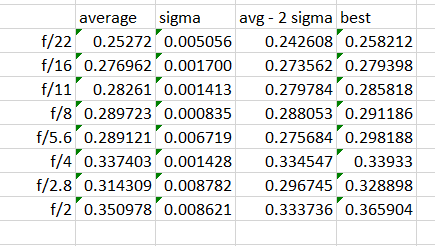I’m been floundering around all day trying to tease out lens sharpness from vibration-induced motion blur in my test shots. This afternoon, the answer finally came to me. Make all the exposures in an aperture series using a strobe for illumination. I set up a Nikon D4 with the Zeiss 100mm ZF macro lens. I focused wide open using live view. I turned off live view. I set the shutter speed to 1/125. I set the f-stop to f/22. I set the strobe for a full dump. I made ten exposures. Then I set the f-stop to f/16, and the strobe to half power, and made ten more exposures. I continued to do that until I was at f/2 (as far as the lens will open) and 1/128 power (as low as the strobe will go).
Here are the results:
What’s going on at f/2.8? it’s worse than both a stop more open and a stop more closed. I think it’s a combination of focus shift, field curvature change, and depth of field. When the lens is wide open, it’s focused close to properly, since I focused wide open. When I stop down to f/2.8, there’s a focus shift and/or I get more field curvature, so I get worse results. When I stop down another stop, there’s enough depth of field to make things sharp again. As I continue to stop down, diffraction ends the party.
It’s looking like I shouldn’t use f/22 with this lens. There also doesn’t seem to be much point in using apertures wider than f/4, especially since the lens vignettes strongly there. The best performance is obtained at f/11 and wider, which means, with my firehouse series, I need to do focus stacking to get the sufficient depth of field. More equipment. More setup time. More work in post. Ugh.

Dear Jim,
I know you are past it, but – the old way is to set bulb exposure in the dark studio and manually trigger the flash.